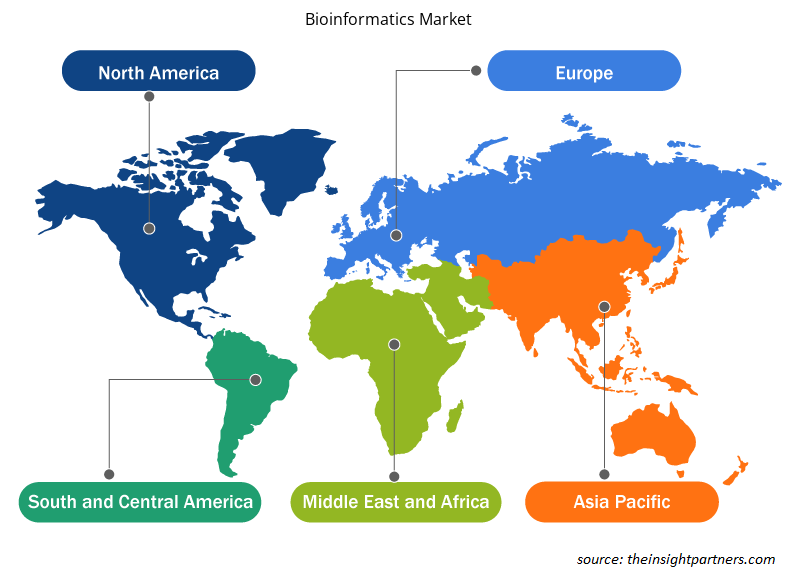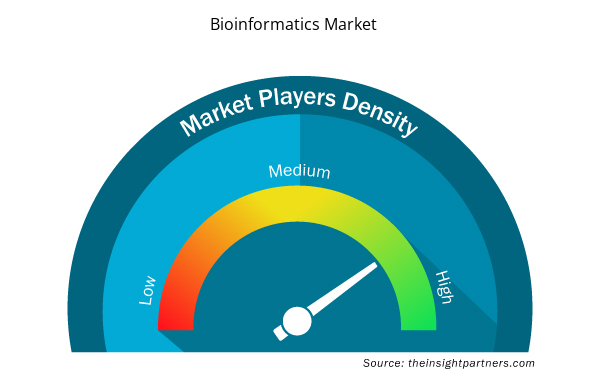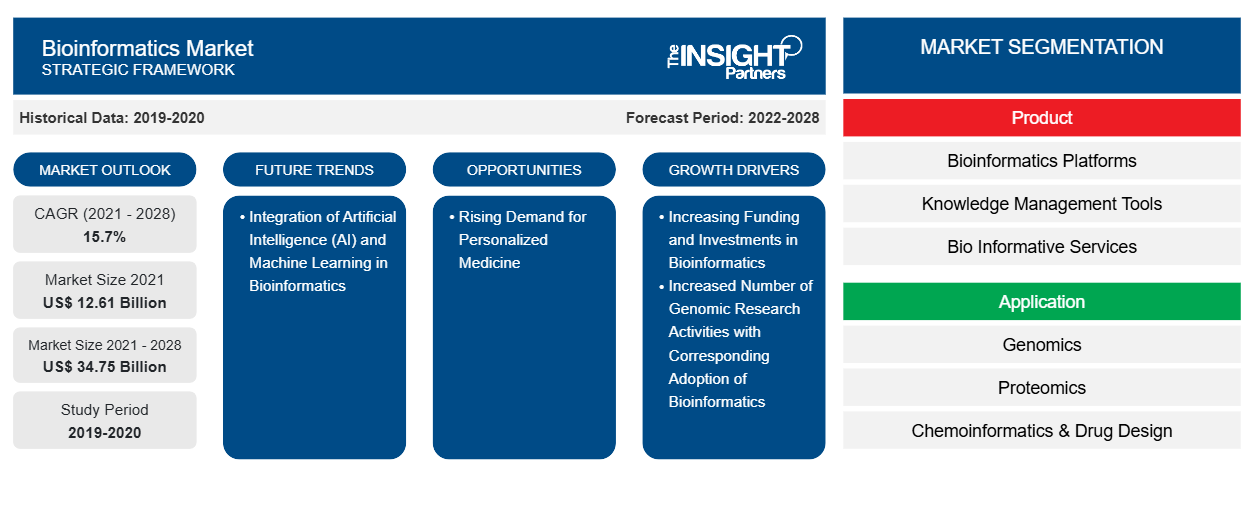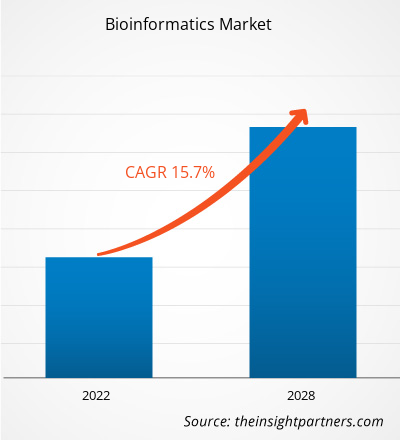[تقرير بحثي] من المتوقع أن ينمو سوق المعلوماتية الحيوية من 12،609.39 مليون دولار أمريكي في عام 2021 إلى 34،749.78 مليون دولار أمريكي بحلول عام 2028؛ ومن المتوقع أن ينمو بمعدل نمو سنوي مركب قدره 15.7٪ من عام 2022 إلى عام 2028.
رؤى السوق ووجهة نظر المحلل:
المعلوماتية الحيوية هي تطبيق تكنولوجيا المعلومات لإدارة البيانات البيولوجية التي تساعد في فك شفرة جينومات النباتات. تخزن المعلوماتية الحيوية البيانات الضخمة الناتجة عن تجارب علوم الحياة، أو التي تم جمعها في سياق سريري، وتحللها وتفسرها. يقود هذا المجال متعدد التخصصات خبراء من خلفيات متنوعة بما في ذلك علماء الأحياء وعلماء الكمبيوتر والرياضيات والإحصائيين والفيزيائيين. تسمح المعلوماتية الحيوية للباحثين بإجراء تجارب على جدول زمني مهم في حياة الشخص. على سبيل المثال، أثناء جائحة فيروس كورونا، تمكن الباحثون من تسلسل جينوم الفيروس، وتحديد ما قد يتسبب في دخول الفيروس إلى الخلايا، وتطوير لقاح يعتمد على الجينوم المكتشف في غضون أشهر. يتم استخدام مناهج المعلوماتية الحيوية الإضافية لتحديد وعلاج أمراض أخرى مثل مرض السكري والسرطان. ويعزى نمو سوق المعلوماتية الحيوية إلى زيادة التمويل والاستثمارات في المعلوماتية الحيوية، ومن المتوقع أن يؤدي زيادة عدد أنشطة البحث الجينومي مع التبني المقابل للمعلوماتية الحيوية إلى دفع نمو سوق المعلوماتية الحيوية خلال الفترة المتوقعة.
محركات النمو والتحديات:
في مجال علم الوراثة وعلم الجينوم، تساعد المعلوماتية الحيوية في تسلسل الجينومات وشرحها. تلعب المعلوماتية الحيوية دورًا في تحليل التعبير الجيني والبروتيني وتنظيمهما. تساعد أدوات المعلوماتية الحيوية في مقارنة البيانات الجينية والجينومية وبشكل عام في فهم الجوانب التطورية لعلم الأحياء الجزيئي. إن دور أبحاث الجينوم البشري والتكنولوجيات الحيوية ذات الصلة لديه القدرة على تحقيق العديد من أهداف الصحة العامة، مثل الحد من التفاوتات الصحية العالمية من خلال تزويد البلدان النامية بوسائل فعالة وفعالة من حيث التكلفة وقوية للوقاية من الأمراض الرئيسية وتشخيصها وعلاجها والتي تثقل كاهل سكانها. حاليًا، من المقرر أيضًا أن يستفيد علاج السرطان من المعلومات الجينية للتنبؤ بكيفية استجابة الفرد للأدوية وإبلاغ وصف الدواء أو الجرعة المناسبة.
تتطور المبادرات الرامية إلى توليد وجمع البيانات الجينومية البشرية بسرعة وتتنوع بشكل كبير، مع مبادرات خاصة وعامة عبر بلدان متعددة. منذ عام 1990، انخفضت تكلفة تسلسل الجينوم بالكامل من 2.7 مليون دولار أمريكي إلى 300 دولار أمريكي فقط، مما فتح فرصًا جديدة لبناء مستودعات للبيانات الجينومية. وبحلول بداية عام 2020، كان هناك 187 مبادرة جينومية على مستوى العالم، 50٪ منها نشأت في الولايات المتحدة و19٪ في أوروبا. تم تحليل ثمانية وثلاثين مليون جينوم باستخدام تقنيات تتراوح من تحديد النمط الجيني إلى تسلسل الجينوم الكامل، ومن المتوقع أن ينمو هذا العدد إلى 52 مليونًا بحلول عام 2025. لذلك، فإن العدد المتزايد من أنشطة الجينوم جنبًا إلى جنب مع التبني المتزايد للمعلوماتية الحيوية هو الذي يقود السوق.
إن أحد التحديات التي تواجهنا هو أن علم المعلومات الحيوية عبارة عن مجموعة من المجالات المختلفة ــ علم الأحياء البنيوي، وعلم الجينوم، وعلم الأحياء الكيميائية، وما إلى ذلك ــ وكلها تتطور بسرعة كبيرة. فالتقنيات الجديدة تظهر على الإنترنت كل يوم تقريبا، وهناك الكثير من أنواع البيانات الجديدة، وبالتالي فإن مواكبة هذا الطوفان من الأشياء الجديدة أمر بالغ الصعوبة.
قم بتخصيص هذا التقرير ليناسب متطلباتك
ستحصل على تخصيص لأي تقرير - مجانًا - بما في ذلك أجزاء من هذا التقرير، أو تحليل على مستوى الدولة، وحزمة بيانات Excel، بالإضافة إلى الاستفادة من العروض والخصومات الرائعة للشركات الناشئة والجامعات
- احصل على أهم اتجاهات السوق الرئيسية لهذا التقرير.ستتضمن هذه العينة المجانية تحليلاً للبيانات، بدءًا من اتجاهات السوق وحتى التقديرات والتوقعات.
تقسيم التقرير ونطاقه:
يتم تقسيم "سوق المعلوماتية الحيوية العالمية" على أساس المنتج والتطبيق والقطاع والجغرافيا. بناءً على المنتج، يتم تقسيم سوق المعلوماتية الحيوية إلى منصات المعلوماتية الحيوية،أدوات إدارة المعرفة، والخدمات المعلوماتية الحيوية. بناءً على التطبيق، يتم تقسيم سوق المعلوماتية الحيوية إلى علم الجينوم، وعلم البروتينات، وعلم المعلومات الكيميائية وتصميم الأدوية، وعلم النسخ، وعلم الأيض، وغيرها. بناءً على القطاع، يتم تقسيم سوق المعلوماتية الحيوية إلى التكنولوجيا الحيوية الطبية، والتكنولوجيا الحيوية الحيوانية، والتكنولوجيا الحيوية الزراعية، والأكاديميين، والتكنولوجيا الحيوية البيئية، والتكنولوجيا الحيوية الجنائية، وغيرها. يتم تقسيم سوق المعلوماتية الحيوية على أساس الجغرافيا إلى أمريكا الشمالية (الولايات المتحدة وكندا والمكسيك)، وأوروبا (ألمانيا وفرنسا وإيطاليا والمملكة المتحدة وروسيا وبقية أوروبا)، وآسيا والمحيط الهادئ (أستراليا والصين واليابان والهند وكوريا الجنوبية وبقية آسيا والمحيط الهادئ)، والشرق الأوسط وأفريقيا (جنوب أفريقيا والمملكة العربية السعودية والإمارات العربية المتحدة وبقية الشرق الأوسط وأفريقيا)، وأمريكا الجنوبية والوسطى (البرازيل والأرجنتين وبقية أمريكا الجنوبية والوسطى)
التحليل القطاعي:
يتم تقسيم سوق المعلوماتية الحيوية بناءً على المنتج إلى منصات المعلوماتية الحيوية وأدوات إدارة المعرفة والخدمات المعلوماتية الحيوية. احتل قطاع منصات المعلوماتية الحيوية أكبر حصة سوقية في عام 2020.1؛ ومع ذلك، من المتوقع أن تسجل أدوات إدارة المعرفة أعلى معدل نمو سنوي مركب خلال فترة التنبؤ. العامل الرئيسي الدافع لنمو هذا القطاع هو العدد المتزايد من تطورات المنتجات الأكثر تقدمًا وأتمتة والتوافر المتزايد في البلدان ذات الدخل المتوسط المنخفض. ساعدت التطورات في منصات المعلوماتية الحيوية سوق المعلوماتية الحيوية على النمو بشكل كبير. على سبيل المثال، في أغسطس 2022، أطلقت Predicine منتجها PredicineCARE الحاصل على علامة CE للتحليل الجيني في الدم والبول في أوروبا. اختبار الحمض النووي الخالي من الخلايا (cfDNA) هو اختبار تسلسل الجيل التالي المستهدف (NGS) للكشف عن متغيرات النوكليوتيدات الفردية والإدخالات والحذف وإعادة ترتيب الحمض النووي واختلافات عدد النسخ لدى المرضى الذين تم تشخيص إصابتهم بالسرطان. تم استخدام الاختبار في التجارب السريرية واختبار المرضى وتطوير التشخيصات المصاحبة.
بناءً على التطبيق، يتم تقسيم سوق المعلوماتية الحيوية إلى علم الجينوم، وعلم البروتينات، وعلم المعلومات الكيميائية وتصميم الأدوية، وعلم النسخ، وعلم الأيض، وغيرها. احتل قطاع الجينوم أكبر حصة في السوق في عام 2021؛ ومع ذلك، من المتوقع أن يسجل علم المعلومات الكيميائية وتصميم الأدوية أعلى معدل نمو سنوي مركب في السوق خلال فترة التوقعات. نظرًا لتطورات المنتجات المبتكرة والبحوث المتزايدة في قطاعات القطاع، سيتم تعزيز نمو القطاع في السنوات القادمة. يعد علم الوراثة حاليًا أحد أكثر العلوم ديناميكية في الطب، وتلعب البيانات الجينية دورًا حيويًا في جميع مجالات الطب. في غضون بضع سنوات، يتم تحويل التطورات التكنولوجية من البحث إلى الاختبارات السريرية، وكان هناك زيادة كبيرة في الاختبارات الجينية المباشرة للمستهلك (DTC). يتلقى المستهلك النتائج عبر الإنترنت، عادةً بدون واجهة بشرية أو استشارة، ثم يطلب المشورة المهنية لاحقًا.
بناءً على القطاع، ينقسم سوق المعلوماتية الحيوية إلى التكنولوجيا الحيوية الطبية، والتكنولوجيا الحيوية الحيوانية، والتكنولوجيا الحيوية الزراعية، والأكاديميين، والتكنولوجيا الحيوية البيئية، والتكنولوجيا الحيوية الشرعية، وغيرها. احتل قطاع التكنولوجيا الحيوية الطبية الحصة الأكبر من السوق في عام 2021 ومن المتوقع أن يسجل أعلى معدل نمو سنوي مركب في السوق خلال فترة التوقعات. العوامل الرئيسية الدافعة لنمو قطاع القطاع هي التطورات المتزايدة والطلب المتزايد على أدوات المعلوماتية الحيوية.
التحليل الإقليمي:
بناءً على الجغرافيا، ينقسم سوق المعلوماتية الحيوية إلى خمس مناطق رئيسية: أمريكا الشمالية وأوروبا وآسيا والمحيط الهادئ وأمريكا الجنوبية والوسطى والشرق الأوسط وأفريقيا. تم تحليل سوق المعلوماتية الحيوية في الشمال بناءً على ثلاث دول رئيسية - الولايات المتحدة وكندا والمكسيك. من المتوقع أن تمتلك الولايات المتحدة أكبر حصة في سوق المعلوماتية الحيوية خلال فترة التنبؤ. بدأت حكومة الولايات المتحدة برامج بحثية مختلفة لتعزيز البحث الجيني، بما في ذلك "برنامج أبحاثنا جميعًا" بقيادة المعاهد الوطنية للصحة، والذي قدم 28.6 مليون دولار أمريكي لتمويل تطوير ثلاثة مراكز جينوم في جميع أنحاء الولايات المتحدة. سيعمل برنامج البحث هذا على تسريع اكتشافات الطب الدقيق من خلال خدمات المعلوماتية الحيوية في مؤسسات مختلفة في الولايات المتحدة. تعمل البيئة الداعمة في الولايات المتحدة على تسريع نمو تطوير وتسويق المنتجات الصيدلانية والبيولوجية. حصل اللاعبون في السوق في البلاد على براءات اختراع مختلفة لابتكاراتهم. وبالتالي، فإن خدمات المعلوماتية الحيوية المتنامية وإطلاق المنتجات لمختلف الدراسات المتعلقة بالأمراض الوراثية والسرطان في الصناعات الدوائية والبيولوجية الصيدلانية من شأنه أن يعزز نمو سوق المعلوماتية الحيوية. على سبيل المثال، في يونيو 2022، قدمت شركة LatchBio الناشئة في مجال أبحاث التكنولوجيا الحيوية في كاليفورنيا منصة معلوماتية حيوية شاملة للتعامل مع بيانات التكنولوجيا الحيوية الضخمة لتسريع الاكتشاف العلمي. وهي تسمح لعلماء الأحياء بتنظيم البيانات وتشغيل العمليات، وعلماء المعلوماتية الحيوية بتحميل تدفقات عمل جديدة، وعلماء الأحياء الحاسوبية بإجراء التحليلات اللاحقة.
كانت منطقة آسيا والمحيط الهادئ المنطقة الأسرع نموًا في سوق المعلوماتية الحيوية العالمية، ومن المتوقع أن تنمو بوتيرة أسرع خلال فترة التوقعات. السوق في هذه المنطقة مملوك بشكل كبير لدول مثل الصين واليابان. العوامل التي تساهم في نمو سوق المعلوماتية الحيوية في هذه البلدان هي التطورات في مجال الجينوميات والبروتينات، مما يولد حجمًا هائلاً من البيانات التي يجب تفسيرها وإدارتها.
اتجاه سوق المعلوماتية الحيوية:
تلعب المعلوماتية الحيوية والذكاء الاصطناعي دورًا حاسمًا في تغيير وتطوير صناعة الرعاية الصحية. في سياق المعلوماتية الحيوية، يمكن استخدام الذكاء الاصطناعي لتعزيز البحث والتحليل السريري الذي يمكن أن يؤدي إلى تصميم أدوية ولقاحات جديدة، وتشخيص الأمراض، وحتى التنبؤ بالأوبئة. أحد الأمثلة على كيفية استخدام الذكاء الاصطناعي جنبًا إلى جنب مع المعلوماتية الحيوية هو التكنولوجيا القابلة للارتداء. المستهلكون على دراية بالفعل بالعديد من أنواع التكنولوجيا القابلة للارتداء، مثل أجهزة تتبع اللياقة البدنية والساعات، ويستخدمون البيانات التي يجمعونها بشكل شخصي. توفر التكنولوجيا القابلة للارتداء بيانات في الوقت الفعلي على مدار فترة زمنية ويمكن أن تساعد في تتبع الاتجاهات وتحديد علامات المشكلات الصحية المميتة المحتملة، مثل أمراض القلب، بشكل أسرع وأكثر دقة من الاختبارات الفورية التي يتم إجراؤها في المختبرات. كما يلعب تسلسل الجينوم دورًا محوريًا في التشخيص الطبي. لقد مكنت تقنيات تسلسل الحمض النووي المدعومة بالتعلم الآلي مثل تسلسل الجيل التالي الباحثين من تسلسل الجينوم البشري في غضون يوم واحد مقارنة بتقنية تسلسل سانجر التقليدية، والتي استغرقت أكثر من عقد من الزمان لتسلسل الجينوم البشري. إن دمج الذكاء الاصطناعي والتعلم الآلي في المعلوماتية الحيوية يظهر الاتجاه الحالي في سوق المعلوماتية الحيوية.
تأثير كوفيد-19:
شهد سوق المعلوماتية الحيوية تأثيرًا إيجابيًا بسبب زيادة الطلب على أدوات الكشف عن كوفيد-19 أثناء الوباء. على المستوى البيولوجي، تتضمن أبحاث SARS-CoV-2 وCOVID-19 تقنيات عالية الإنتاجية مثل تسلسل الجيل التالي للكشف عن جينوم SARS-CoV-2، وقواعد البيانات التي تخزن جينومات ومتغيرات SARS-CoV-2، وأدوات برمجيات المعلوماتية الحيوية وقواعد البيانات لتحليل وتخزين تفاعلات الفيروس المضيف. على المستوى الطبي، كان البحث عن استراتيجيات علاجية، وتحديد المؤشرات الحيوية لكوفيد-19، واكتشاف الأهداف العلاجية للأدوية، ونهج المعلوماتية الحيوية لإعادة استخدام الأدوية، أي استخدام الأدوية المتاحة بالفعل لمرض كوفيد-19، هي الموضوعات البحثية الرئيسية، والتي أدت إلى تصعيد نمو السوق. علاوة على ذلك، كان هناك زيادة في استخدام التقنيات القائمة على الجينات الاصطناعية لدراسة ضراوة SARS-CoV-2 وتسهيل تطوير اللقاح.
لقد أحدثت الاختراعات والتطورات التي شهدتها تقنيات تضخيم الأحماض النووية، وتسلسل الحمض النووي الآلي، وأدوات المعلوماتية الحيوية ثورة في توصيف وتصنيف جميع مسببات الأمراض المعدية خلال العقدين الأخيرين. ويشكل الدمج المتزايد لمنهجيات وتقنيات المعلوماتية الحيوية في العديد من مجالات الاستجابة العالمية لجائحة كوفيد-19 دليلاً آخر حاسماً وواضحاً على الدور الأساسي للمعلوماتية الحيوية في العلوم والطب الحديثين.
رؤى إقليمية حول سوق المعلوماتية الحيوية
لقد قام المحللون في Insight Partners بشرح الاتجاهات والعوامل الإقليمية المؤثرة على سوق المعلوماتية الحيوية طوال فترة التوقعات بشكل شامل. يناقش هذا القسم أيضًا قطاعات سوق المعلوماتية الحيوية والجغرافيا في جميع أنحاء أمريكا الشمالية وأوروبا ومنطقة آسيا والمحيط الهادئ والشرق الأوسط وأفريقيا وأمريكا الجنوبية والوسطى.

- احصل على البيانات الإقليمية المحددة لسوق المعلوماتية الحيوية
نطاق تقرير سوق المعلوماتية الحيوية
| سمة التقرير | تفاصيل |
|---|---|
| حجم السوق في عام 2021 | 12.61 مليار دولار أمريكي |
| حجم السوق بحلول عام 2028 | 34.75 مليار دولار أمريكي |
| معدل النمو السنوي المركب العالمي (2021 - 2028) | 15.7% |
| البيانات التاريخية | 2019-2020 |
| فترة التنبؤ | 2022-2028 |
| القطاعات المغطاة | حسب المنتج
|
| المناطق والدول المغطاة | أمريكا الشمالية
|
| قادة السوق وملفات تعريف الشركات الرئيسية |
|
كثافة اللاعبين في سوق المعلوماتية الحيوية: فهم تأثيرها على ديناميكيات الأعمال
يشهد سوق المعلوماتية الحيوية نموًا سريعًا، مدفوعًا بالطلب المتزايد من المستخدم النهائي بسبب عوامل مثل تفضيلات المستهلكين المتطورة والتقدم التكنولوجي والوعي المتزايد بفوائد المنتج. ومع ارتفاع الطلب، تعمل الشركات على توسيع عروضها والابتكار لتلبية احتياجات المستهلكين والاستفادة من الاتجاهات الناشئة، مما يؤدي إلى زيادة نمو السوق.
تشير كثافة اللاعبين في السوق إلى توزيع الشركات أو المؤسسات العاملة في سوق أو صناعة معينة. وهي تشير إلى عدد المنافسين (اللاعبين في السوق) الموجودين في مساحة سوق معينة نسبة إلى حجمها أو قيمتها السوقية الإجمالية.
الشركات الرئيسية العاملة في سوق المعلوماتية الحيوية هي:
- أنظمة داسو
- شركة بروكر
- شركة اجيلنت للتكنولوجيا
- يوروفينز العلمية
- شركة إيلومينا
إخلاء المسؤولية : الشركات المذكورة أعلاه ليست مرتبة بأي ترتيب معين.

- احصل على نظرة عامة على أهم اللاعبين الرئيسيين في سوق المعلوماتية الحيوية
المنافسة والشركات الرئيسية:
تشمل بعض الشركات البارزة العاملة في سوق المعلوماتية الحيوية العالمية شركة Agilent Technologies, Inc، وBiomax Informatics Ag، وBruker Corporation، وDassault Systems، وEurofins Scientific، وGeneva Bioinformatics، وIllumina، وPerkinElmer، وQiagen، وThermoFisher Scientific, Inc. وغيرها. تركز هذه الشركات على التقنيات الجديدة والتقدم في المنتجات الحالية والتوسع الجغرافي لتلبية الطلب المتزايد من المستهلكين في جميع أنحاء العالم وزيادة نطاق منتجاتها في محافظ التخصصات. على سبيل المثال، في مارس 2020، أطلقت شركة Genesis Healthcare Co.، الشركة الرائدة في مجال الاختبارات الجينية والبحث في اليابان، أداة GenesisGaia الجديدة لسوق البيانات الجينومية للبحث والتطوير في اليابان لتمكين الباحثين في الصناعة من خلال زيادة إنتاجيتهم في التطبيقات الحاسمة مثل تسريع اكتشاف الأدوية والتطوير السريري والطب الدقيق، فضلاً عن تعزيز تطوير المنتجات والخدمات الاستهلاكية الشخصية.
في يناير 2021، قامت شركة Illumina, Inc. بتحويل الاختناقات في البيانات الجينومية إلى محفزات من خلال إطلاق Illumina Connected Analytics (ICA). يوفر حل المعلوماتية الحيوية الجديد والمتكامل منصة بيانات شاملة وخاصة ومبنية على السحابة تمكن العملاء من إدارة وتحليل واستكشاف كميات كبيرة من البيانات متعددة الجينات في بيئة آمنة وقابلة للتطوير ومرنة.
- التحليل التاريخي (سنتان)، السنة الأساسية، التوقعات (7 سنوات) مع معدل النمو السنوي المركب
- تحليل PEST و SWOT
- حجم السوق والقيمة / الحجم - عالميًا وإقليميًا وقطريًا
- الصناعة والمنافسة
- مجموعة بيانات Excel



Report Coverage
Revenue forecast, Company Analysis, Industry landscape, Growth factors, and Trends

Segment Covered
This text is related
to segments covered.

Regional Scope
North America, Europe, Asia Pacific, Middle East & Africa, South & Central America

Country Scope
This text is related
to country scope.
الأسئلة الشائعة
The medical biotechnology segment dominated the global bioinformatics market and held the largest market share of 29.18% in 2021.
Thermo Fisher Scientific and Agilent Technologies, Inc. are the top two companies that hold huge market shares in the bioinformatics market.
Global bioinformatics market is segmented by region into North America, Europe, Asia Pacific, Middle East & Africa, and South & Central America. The North America region is the held the largest market for the bioinformatics market during the forecast period. The large share of North America is attributed to factors such as the presence of decreased cost of sequencing, leading bioinformatics providers, government support for genomic research, increased awareness of bioinformatics services, and increased number of genomic research activities in the region are driving the growth of the bioinformatics market in North America. Also, it has a favorable funding scenario for research activities.
The CAGR value of the bioinformatics market during the forecasted period of 2022-2028 is 15.7%.
The bioinformatics platforms segment held the largest market share of 48.47% in 2021 in the global bioinformatics market.
Key factors that are driving the growth of this market increasing funding and investments in bioinformatics and increased number of genomic research activities with the corresponding adoption of bioinformatics are expected to boost the market growth for bioinformatics over the years.
The genomics segment dominated the global bioinformatics market and accounted for the largest market share of 28.33% in 2021.
Bioinformatics, as associated with genetics and genomics, is a scientific subdiscipline that involves using computer technology to collect, store, analyze and disseminate biological data and information, such as DNA and amino acid sequences or observations about those sequences. Bioinformatics is essential for the management of data in modern biology and medicine. Scientists and clinicians use databases that organize and guide biological information to increase the understanding of health and disease and, in certain cases, as part of medical care.
The Bioinformatics market majorly consists of the players such as Agilent Technologies, Inc, Biomax Informatics Ag, Bruker Corporation, Dassault Systems, Eurofins Scientific, Geneva Bioinformatics, Illumina, Perkinelmer, Qiagen, Thermofisher Scientific, Inc. among others.
The bioinformatics research during the COVID-19 pandemic has given an impulse to the development and adaption of various informatics techniques, including computational methods for tracing and tracking infected people, artificial intelligence methods and robotics applications to support remote patients assistance, collaborative data infrastructures for COVID-19 research and sentiment analysis methods for monitoring the impact of lockdown measures. The introduction of genomics and bioinformatics have contributed immensely to understand infectious disease from disease pathogenesis, mechanisms and the spread of antimicrobial resistance to host immune responses.
The List of Companies - Bioinformatics Market
- Dassault Systèmes
- Bruker Corporation
- Agilent Technologies, Inc.
- Eurofins Scientific
- Illumina, Inc.
- PerkinElmer Inc.
- QIAGEN
- Thermo Fisher Scientific Inc.
- Biomax Informatics AG
- Genebio
The Insight Partners performs research in 4 major stages: Data Collection & Secondary Research, Primary Research, Data Analysis and Data Triangulation & Final Review.
- Data Collection and Secondary Research:
As a market research and consulting firm operating from a decade, we have published and advised several client across the globe. First step for any study will start with an assessment of currently available data and insights from existing reports. Further, historical and current market information is collected from Investor Presentations, Annual Reports, SEC Filings, etc., and other information related to company’s performance and market positioning are gathered from Paid Databases (Factiva, Hoovers, and Reuters) and various other publications available in public domain.
Several associations trade associates, technical forums, institutes, societies and organization are accessed to gain technical as well as market related insights through their publications such as research papers, blogs and press releases related to the studies are referred to get cues about the market. Further, white papers, journals, magazines, and other news articles published in last 3 years are scrutinized and analyzed to understand the current market trends.
- Primary Research:
The primarily interview analysis comprise of data obtained from industry participants interview and answers to survey questions gathered by in-house primary team.
For primary research, interviews are conducted with industry experts/CEOs/Marketing Managers/VPs/Subject Matter Experts from both demand and supply side to get a 360-degree view of the market. The primary team conducts several interviews based on the complexity of the markets to understand the various market trends and dynamics which makes research more credible and precise.
A typical research interview fulfils the following functions:
- Provides first-hand information on the market size, market trends, growth trends, competitive landscape, and outlook
- Validates and strengthens in-house secondary research findings
- Develops the analysis team’s expertise and market understanding
Primary research involves email interactions and telephone interviews for each market, category, segment, and sub-segment across geographies. The participants who typically take part in such a process include, but are not limited to:
- Industry participants: VPs, business development managers, market intelligence managers and national sales managers
- Outside experts: Valuation experts, research analysts and key opinion leaders specializing in the electronics and semiconductor industry.
Below is the breakup of our primary respondents by company, designation, and region:

Once we receive the confirmation from primary research sources or primary respondents, we finalize the base year market estimation and forecast the data as per the macroeconomic and microeconomic factors assessed during data collection.
- Data Analysis:
Once data is validated through both secondary as well as primary respondents, we finalize the market estimations by hypothesis formulation and factor analysis at regional and country level.
- Macro-Economic Factor Analysis:
We analyse macroeconomic indicators such the gross domestic product (GDP), increase in the demand for goods and services across industries, technological advancement, regional economic growth, governmental policies, the influence of COVID-19, PEST analysis, and other aspects. This analysis aids in setting benchmarks for various nations/regions and approximating market splits. Additionally, the general trend of the aforementioned components aid in determining the market's development possibilities.
- Country Level Data:
Various factors that are especially aligned to the country are taken into account to determine the market size for a certain area and country, including the presence of vendors, such as headquarters and offices, the country's GDP, demand patterns, and industry growth. To comprehend the market dynamics for the nation, a number of growth variables, inhibitors, application areas, and current market trends are researched. The aforementioned elements aid in determining the country's overall market's growth potential.
- Company Profile:
The “Table of Contents” is formulated by listing and analyzing more than 25 - 30 companies operating in the market ecosystem across geographies. However, we profile only 10 companies as a standard practice in our syndicate reports. These 10 companies comprise leading, emerging, and regional players. Nonetheless, our analysis is not restricted to the 10 listed companies, we also analyze other companies present in the market to develop a holistic view and understand the prevailing trends. The “Company Profiles” section in the report covers key facts, business description, products & services, financial information, SWOT analysis, and key developments. The financial information presented is extracted from the annual reports and official documents of the publicly listed companies. Upon collecting the information for the sections of respective companies, we verify them via various primary sources and then compile the data in respective company profiles. The company level information helps us in deriving the base number as well as in forecasting the market size.
- Developing Base Number:
Aggregation of sales statistics (2020-2022) and macro-economic factor, and other secondary and primary research insights are utilized to arrive at base number and related market shares for 2022. The data gaps are identified in this step and relevant market data is analyzed, collected from paid primary interviews or databases. On finalizing the base year market size, forecasts are developed on the basis of macro-economic, industry and market growth factors and company level analysis.
- Data Triangulation and Final Review:
The market findings and base year market size calculations are validated from supply as well as demand side. Demand side validations are based on macro-economic factor analysis and benchmarks for respective regions and countries. In case of supply side validations, revenues of major companies are estimated (in case not available) based on industry benchmark, approximate number of employees, product portfolio, and primary interviews revenues are gathered. Further revenue from target product/service segment is assessed to avoid overshooting of market statistics. In case of heavy deviations between supply and demand side values, all thes steps are repeated to achieve synchronization.
We follow an iterative model, wherein we share our research findings with Subject Matter Experts (SME’s) and Key Opinion Leaders (KOLs) until consensus view of the market is not formulated – this model negates any drastic deviation in the opinions of experts. Only validated and universally acceptable research findings are quoted in our reports.
We have important check points that we use to validate our research findings – which we call – data triangulation, where we validate the information, we generate from secondary sources with primary interviews and then we re-validate with our internal data bases and Subject matter experts. This comprehensive model enables us to deliver high quality, reliable data in shortest possible time.


 احصل على عينة مجانية لهذا التقرير
احصل على عينة مجانية لهذا التقرير